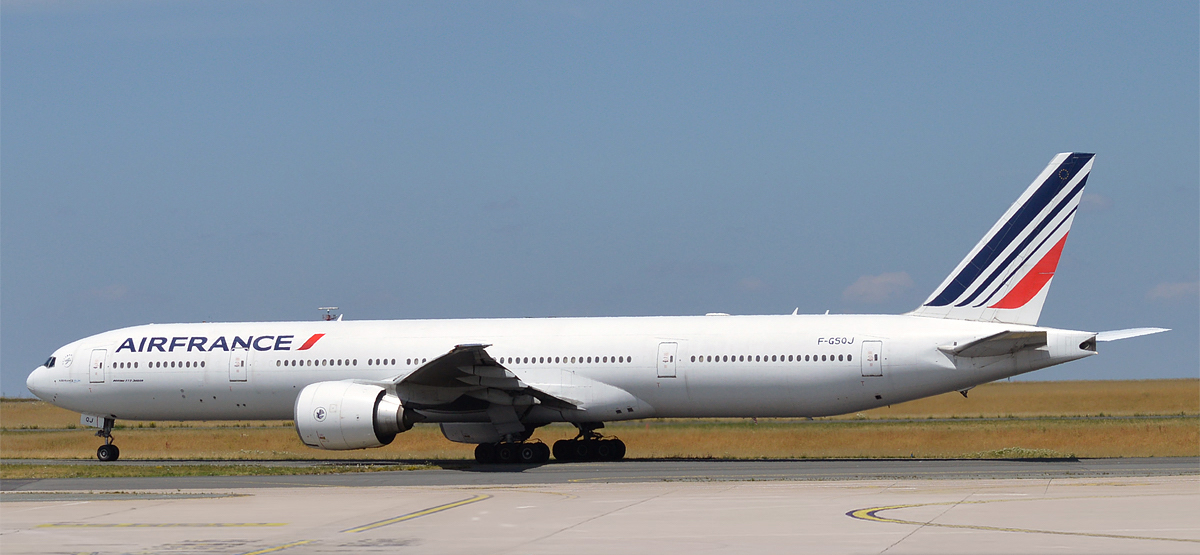
Sobering air traffic control audio reveals the panic that an Air France flight crew experienced when their Boeing 777-300ER suddenly became unresponsive during final approach in Paris.
Air France 777-300ER Fails To Respond To Pilot Input, Veers Left On Approach To Paris CDG
The incident occurred on Air France 11, traveling from New York (JFK) to Paris (CDG) on April 5th. The issue occurred during final approach to runway 26L and involved a Boeing 777-300ER (registration F-GSQJ).
Listen to the audio below, which includes a harrowing interval in which pilots audibly struggle for control of the aircraft, telling air traffic control (ATC) that the plane was not responding to commands and veering to the left.
After an aborted landing, the aircraft stabilized at 1,200 feet, climbed to 4,000 feet, and then was able to successfully land on runway 27R at CDG, also known as Roissy Airport.
Air France has issued a statement about AF11, calling the issue a “technical incident”:
Air France confirms that the crew of flight AF011 on 4 April 2022 from New York JFK to Paris-CDG aborted their landing sequence and performed a go-around due to a technical incident during the approach.
The crew mastered the situation and landed the aircraft normally after a second approach. Air France understands and regrets the discomfort felt by customers.
The go-around is defined by the authorities, aircraft manufacturers and Air France as a normal procedure. The crews are trained and regularly instructed in these procedures, which are used by all airlines to guarantee the safety of flights and passengers, which is an absolute necessity for Air France.
I won’t speculate here what caused the issue, but would certainly welcome input from pilots in the comments section below. Based upon the way in which the pilot screamed, “STOP! STOP! STOP IT!” it seems to me this was not an ordinary emergency.
CONLCUSION
Kudos to the Air France flight crew for landing the plane and keeping everyone onboard safe. It isn’t clear what happened onboard, but I trust we will soon find out.
image: Anna Zvereva (the actual aircraft)




I heard the ATC communications earlier and this was anything but a routine situation. They were clearly panicked and alarms were going off all around them in the cockpit. Of course, given the nature of Air France (or any airline) they will downplay this incident. (Ok, especially Air France) But something pretty significant occurred, whether pilot error or some major system malfunction. I would guess they were a few hundred feet from something far worse than the outcome. I hope there is an investigation and they find out what happened as this is very bizarre.
Why aren’t they speaking English?
French is one of the approved languages for ATC to use with pilots. While English is the necessary default you will find these other approved languages used as well when and where appropriate.
I did not know that.
Had the same q. thx for answering
The reason that a common language (English) was agreed upon was so all pilots on that frequency could understand what was being said. This helps prevent two aircraft from accepting clearance to the same navigational fix or altitude at the same time. It could have been French, German, Spanish, whatever. They just wanted to avoid an ATC “Tower of Babel”.
Why should they be speaking English?
It’s the common language of international civil aviation.
Arabic, Chinese, French, Russian and Spanish are also acceptable languages per the International Civil Aviation Organization.
Why is this question always coming back with French airports ATC recordings?
Just like ATC in Spain or Latin America will speak Spanish with Spanish speaking pilots, ATC in Russia in Russian,..
I agree it may be not so good for the general awareness of the other non French planes on the same frequency, it is still legal.
Interestingly, I have heard Russian pilots speak English to Russian ATC while other Russian pilots at the same time talk to ATC in Russian. I heard it when listening to LiveATC once for Moscow SVO, it was pretty interesting. The ones that did speak Russian seemed to be Aeroflot only, but I presume other Aeroflot pilots were speaking in Russian. Wonder why it differs. Maybe intl vs domestic flights?
There are 5, repeat 5 “official” aviation languages in the aviation world. Yes, most are conducted in English, yet other languages are still legitimate. You can look it up on the ICAO’s website for further details and information.
Eeeks! These audios give me agita. Thank the heavens that they were able to land. Merci to the pilot and crew.
I’m not a pilot or have any experience to base this on. But it kind of sounds like pilot error. Based on this short clip you don’t hear them working through a check list or troubleshooting a problem. Whatever the issue was, they seem to have corrected it and were comfortable that they had full control of the plane.
The audio clip in the video are communications between ATC and the pilots. It doesn’t include the conversation between the pilots and what they were doing/saying. Plus, the audio clip is likely shortened to remove silences/unrelated comms. Therefore you can’t really infer whether they did do their checklists or not.
I acknowledged in my response it was a short clip, if you paid attention. Regarding the checklist comment, again you’re stating the obvious. I was just pointing out, in the short clip, there was no mention made of troubleshooting.
Why would the pilot use the ATC frequency to do his check list and keep busy the frequency? This is absolutely not standard procedure. It would even be reported.
Geez thanks Captain Obvious. Of course they don’t. The point, which appears to have sailed way over head, no mention was made of needing time to carry out any troubleshooting.
It may indeed have been pilot error, but you cannot interfer this from the audio recording Matthew linked, and certainly not from the absence of troubleshooting in a period spanning 37 seconds (0:40 first recording of issue to 1:17 notification of go around).
The first rule of flying – especially in a situation that does not go as planned – is FLY THE PLANE (Pilots use the expression “aviate, navigate, communicate” to remember their priorities). If you are some 300 meters above ground and the plane is not on a stable path to the runway, you do not have time to do anything else than to make sure the plane stays in the air in a stable and safe manner. This is even more important when flying in a heavily used airspace, such as above Paris. Here, aviate and communicate take utmost priority as you need to (1) stay in the air, and (2) make sure you do not crash into somebody.
You’d be surprised how relatively “late” checklists and troubleshooting comes into play. In this case, the pilots would execute a go-around immediately, communicate this to ATC, and then read the go-around checklist only after they have safely departed their landing trajectory (i.e. nose up, adequate power, adequate flap position, gear up). They simply do not have time to do anything else in this situation, especially not in the period that is covered by the audio recording.
And if you listen again to the recording, you hear that the pilot is telling ATC that they need time and airspace to work the problem out before they approach for landing again (1:48) after their go-around – contrary to your argument that the pilots did not mention troubleshooting.
However, given that the plane was on an ILS approach when the problems occured, it seems reasonable to assume that either the plane’s ILS system had a technical or software malfunction and/or was wrongly configured by the flight crew (other planes appear to have landed without issue on this runway before or after), especially since the plane landed without issue on another runway. It seems like the flight crew disconnected the plane-based ILS system and put her down manually (as manually as fly-by-wire allows). Yet an issue with ILS does not allow one to infer pilot error, especially not with our lack of information. Another, more extreme hypothesis, would be a hack of either the plane or the system, or accidental interference by recently installed 5G antennas (if there are any near CDG).
Yes, David…it’s very clear you are not a pilot. It’s also very clear you have no idea what you’re talking about. The ignorance you displayed repeatedly is staggering.
Stick to what you know, because you’re beyond clueless about this. You know literally nothing.
Not sure what’s worse, the display of ignorance, or the fact you still argued when someone took the effort to try to educate you.
Staggeringly obtuse.
As a cardiologist who treats multiple pilots, I find this quite humorous. I can tell that when it comes to their own medical care, many pilots think they more than us doctors!
Sounds like the SFO Asiana incident ~5 yrs ago. The crew misconfigured the autopilot, was not watching the plane closely and when they realized it, it was too late. The airplane appeared not to respond but it takes awhile to ‘spool up’ from the slow speed. They hit very hard but barley stayed out of the Bay. Maybe someone remembers better than I do the NTSB findings but really came down to crew error; the PIC not listening to other crew and other crew not as vocal as they could be. Please correct me…
I think several things could have cause the aircraft to veer off course to the left. The first thing that came to mind was the ILS. Did another aircraft, ground vehicle or something interrupt the signal between the ILS and the aircraft? Or was the aircraft not properly configured for the type of landing they were attempting to execute?
As far as the controls not responding immediately at slower speeds it takes time for an aircraft the size of a 77W to respond because there isn’t that much air flowing over the ailerons and it also takes time for the engines to spool up to produce the thrust needed to increase speed of the aircraft which would make the controls a bit quicker to respond.
Scary!
Hi Mathew,
Jason here (your former UCLA classmate and pilot). Sounds like pilot error to me, the CDU and/or autopilot were likely misconfigured (possibly for a sidestep to a different runway). I doubt there was an actual control problem – the 777 and its computers are time tested without any such issues.
Thank you Jason. Sounds logical. Always good to hear from you – text me next time you’re in LA.
Sounds like they had multiple autopilot disconnect and over speed / config chimes. Hmmm…
I was on that flight and instantly knew it was not “turbulence”, as the Pilot claimed it to have been. Thanks to those above who added solid discussion to help me understand what could have potentially occurred.
How did you experience the go-around?
I could tell the pilots had trouble regaining control of the aircraft up until it reached/leveled off around 4000’.
We circled for 15-20 min, which further led me to believe it was not “turbulence” as the pilot mentioned.
Personally, I didn’t not feel as if we were in danger, but after reading reports, it appears we were in some sort of danger.
My wife’s Cousin passed away in the Valuejet tragedy in South Florida. So, this just adds to more stress for her.
It turns out this incident was entirely pilot error. Inexcusable, especially considering the AF447 crash. The captain yelling, “Stop it” instead of using the proper command to the FO just makes it worse. Giving Kudos to the crew in this article may have seemed appropriate at the time, but the crew should be sent on their way. They need to be much better trained.
This near disaster reflects very poorly on Air France.
Happened again Aug 4 2023 I was on Air France flight 8 to JFK they canceled the first landing at 15 feet and went back to 1300 feet. they said it was low cloud cover….I don’t believe it was.